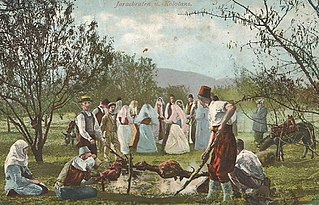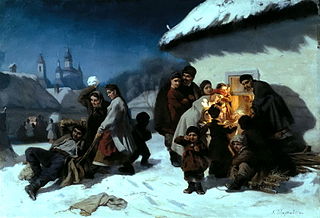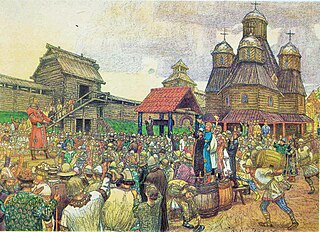 W
WSlavic carnivals are known under different names in various Slavic countries: [Macedonian language: 'Прочка'(Prochka)], Bulgarian:Сирни заговезни, Прошка, Russian: Масленица, Мясопуст, Polish: Ostatki, Mięsopust, Zapusty, Czech: Masopust, Šibřinky, Ostatky, Slovak: Fašiangy, Slovene: Mesopȗst, Pust, Pustni teden, Fašnk, Serbian: Покладе, Poklade, Croatian: Pust, Poklade, Mesopust, Fašnik. They are traditional Slavic festivals related to the period of carnival.
 W
WBirch bark manuscripts are documents written on pieces of the inner layer of birch bark, which was commonly used for writing before the advent of mass production of paper. Evidence of birch bark for writing goes back many centuries and in various cultures.
 W
WBread and salt is a welcome greeting ceremony in some Slavic, Nordic, Baltic, Balkan and other European cultures as well as in Middle Eastern cultures. The tradition, known by local Slavic names was also adopted by three non-Slavic nations — Lithuanians, Latvians and Romanians (Romance) — all three of which are culturally and historically close to their Slavic neighbours. It is also common in Albania, Armenia, the Jewish diaspora, and the Middle East. This tradition has also been observed in spaceflight.
 W
WCatholic Slavs and Slavic Catholic are terms used for the historically and/or predominantly Catholic Slavic ethnic groups and nations and for the history of Catholicism among the Slavic peoples. The Catholic Slavic nations include all West Slavs as well as the westernmost South Slavs.
 W
WThe Slavs were Christianized in waves from the 7th to 12th century, though the process of replacing old Slavic religious practices began as early as the 6th century. Generally speaking, the monarchs of the South Slavs adopted Christianity in the 9th century, the East Slavs in the 10th, and the West Slavs between the 9th and 12th century. Saints Cyril and Methodius are attributed as "Apostles to the Slavs", having introduced the Byzantine-Slavic rite and Glagolitic alphabet, the oldest known Slavic alphabet and basis for the Early Cyrillic alphabet.
 W
WThe culture of Bosnia and Herzegovina encompasses the country's ancient heritage, architecture, literature, visual arts, music, cinema, sports and cuisine.
 W
WCyril and Methodius (815–885) were two brothers and Byzantine Christian theologians and missionaries. For their work evangelizing the Slavs, they are known as the "Apostles to the Slavs".
 W
WThe czupryna, also known as the Polish halfshaven head, is a traditional Polish noble haircut, associated mainly with sarmatism, but worn by Poles in the Middle Ages too. It is marked by shaving hair above the ears and on the neck on the same height, with longer hair on the top of the head. For hundreds of years it was typical of Poles.
 W
WDożynki is a Slavic harvest festival. In pre-Christian times the feast usually fell on the autumn equinox, in modern times it is usually celebrated on one of the Sundays following the end of the harvest season, which fall on different days in different regions of Europe.
 W
WDziady is a term in Slavic folklore for the spirits of the ancestors and a collection of pre-Christian rites, rituals and customs that were dedicated to them. The essence of these rituals was the "communion of the living with the dead", namely, the establishment of relationships with the souls of the ancestors, periodically returning to their headquarters from the times of their lives. The aim of the ritual activities was to win the favor of the deceased, who were considered to be caretakers in the sphere of fertility. The name "dziady" was used in particular dialects mainly in Belarus, Polesia, Russia and Ukraine, but under different other names there were very similar ritual practices, common among Slavs and Balts, and also in many European and even non-European cultures.
 W
WThe Eastern Orthodox Slavs form a religious grouping of the Slavic peoples, including ethnic groups and nations that predominantly adhere to the Eastern Orthodox Christian faith and whose Churches follow the Byzantine Rite liturgy. Orthodoxy spread to Eastern Europe in the Early Middle Ages through Byzantine influence, and has been retained in several countries until today.
 W
WThe Glagolitic script is the oldest known Slavic alphabet. It is generally agreed to have been created in the 9th century by Saint Cyril, a monk from Thessaloniki. He and his brother, Saint Methodius, were sent by the Byzantine Emperor Michael III in 863 to Great Moravia to spread Christianity among the West Slavs in the area. The brothers decided to translate liturgical books into the contemporary Slavic language understandable to the general population. As the words of that language could not be easily written by using either the Greek or Latin alphabets, Cyril decided to invent a new script, Glagolitic, which he based on the local dialect of the Slavic tribes from the Byzantine theme of Thessalonica.
 W
W"Hey, Slavs" is a patriotic song dedicated to the Slavs which was used as the national anthem of various countries during the 20th century.
 W
WKoliada or koleda is the traditional Slavic name for the period from Christmas to Epiphany or, more generally, to Slavic Christmas-related rituals, some dating to pre-Christian times. It represents "a winter festival celebrated at the end of December in honour of the sun".
 W
WKoliada or Koleda is a Slavic mythological deity, that personalizes the newborn winter infant Sun and impersonates the New Year's cycle. It is connected with the solar cycle, passing through the four seasons and from one substantial condition into another.
 W
WKolt or kolty was a part of a female headgear, hanging on a ryasna at both temples as a sign of family's wealth, common in 11th-13th centuries in Old Rus'. It comprised a pair of metal pieces, joined to form a hollow medallion or star that, presumably, contained a piece of cloth, impregnated with fragrances.
 W
WKolyadka are traditional songs usually sung in Eastern Slavic, Central Europe and Eastern Europe countries during the Christmas holiday season which is typically between January 7 and 14. At the same time Ukrainians sing kolyadkas and schedrivkasuk between December 19 and January 19. Catholic Christians and Protestants living in these countries sing kolyadkas on and near Christmas Eve. It is believed that everything sung about will come true.
 W
WMushroom hunting, mushrooming, mushroom picking, mushroom foraging, and similar terms describe the activity of gathering mushrooms in the wild, typically for culinary use. This practice is popular throughout most of Europe, Australia, Japan, Korea, parts of the Middle East, and the Indian subcontinent, as well as the temperate regions of Canada and the United States.
 W
WDe orthographia bohemica is a Latin work published between 1406 and 1412. It is attributed to Charles University rector and reformer Jan Hus. The book codified the Czech language's modern spelling and orthography and had decisive impact on the orthography of a number of other European languages.
 W
WThe Pan-Slavic colors — red, blue and white — were defined by the Prague Slavic Congress, 1848, based on the flag of Russia, which was introduced in the late 17th century. The tricolor flag of Russia was itself inspired by the flag of the Netherlands. Historically, many Slavic nations and states adopted flags and other national symbols that used some combination of those three colors. List of Slavic countries that use or have used the colors include: Russia, Yugoslavia, Czechoslovakia, Czech Republic, Montenegro, Slovakia, Croatia, Serbia and Slovenia. On the other hand, Belarus, Bulgaria, North Macedonia, Poland and Ukraine have never adopted all the colors.
 W
WThe Panslavic Congress of Singers was an international assembly of choirs and associations of singers which took place in Poznań between May 18th and 21st, 1929, during the commencement of the Polish General Exhibition. It was connected with the First Polish Music Festival.
 W
WA rushnyk or rushnik is a ritual cloth embroidered with symbols and cryptograms of the ancient world. They have been used in sacred Eastern Slavic rituals, religious services and ceremonial events such as weddings and funerals. Each region has its own designs and patterns with hidden meaning, passed down from generation to generation and studied by ethnographers.
 W
WThe culture of the Russians, along with the cultures of many other minority ethnic groups in the country—has a long tradition of achievement in many fields, especially when it comes to literature, folk dancing, philosophy, classical music, traditional folk-music, ballet, architecture, painting, cinema, animation and politics. In all these areas Russia has had a considerable influence on global culture. Russia also has a rich material culture and a tradition in science and technology.
 W
WRyasna was a part of a woman’s headgear, hanging from a diadem or as a temporal pendant.
 W
WThe Slava is a Serbian Orthodox Christian tradition of the ritual glorification of one's family's patron saint. The family celebrates the Slava annually on the saint's feast day. In November 2014 it was inscribed in UNESCO Intangible Cultural Heritage Lists.
 W
WGiven names originating from the Slavic languages are most common in Slavic countries.
 W
WEpifany Slavinetsky was an ecclesiastical expert of the Russian Orthodox Church who helped Patriarch Nikon to revise ancient service-books. His actions precipitated the raskol, the great schism of the national church.
 W
WVeche was a popular assembly in medieval Slavic countries.